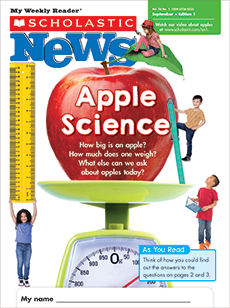Academic Standards
Learning Objective:
Children will identify good work habits.
Social and Life Skills Focus:
self-management
Page 4 Skill:
encoding words
Vocabulary:
habit, materials
CCSS:
RI.1.1 ask and answer questions; RI.1.4 determine meaning of words; RI.1.10 read informational texts; RF.1.2 vowels; SL.1.1 participate in collaborative conversations
Watch the video
Watch the video
Build background knowledge about being part of a class by watching “Five Ways to Try Your Best.” When you’re done watching, ask students the following question: How will you try your best?
Preview new vocabulary words
Preview new vocabulary words
Project the online vocabulary slideshow and introduce this issue’s featured words.
Set a purpose for reading
Set a purpose for reading
- Have students do a picture walk through the issue, then read and discuss the cover. Ask students to practice raising their hands. Why do they think that is an important habit to have?
- Then, before turning to page 2, say, “As we read the article, think about which habits you have and which ones you are working on.”
- As you read, pause after each box. Have students share whether they have each habit by saying, “hop, hop, hooray!”
- When you’re done reading, ask children to turn and talk with a partner. Which habits are they still working on?
- Reading Checkpoint (skill: reading comprehension)
- My Work Habits (skill: self-management)
- Color by Vowel Sound (skill: long and short vowels)
Play the online game: Make School Bus Words
(skill: encode words)
Complete a hands-on activity: Habit Rabbit Hop!
Kids write and draw about a habit they are working on, decorate and wear rabbit ears, then have a hopping dance party in celebration of their new goals. (skill: self-management)
Read a paired text
Kids aren’t the only ones who need to get ready for school! In How to Get Your Teacher Ready by Jean Reagan, a class has tips and tricks to help their teacher prepare for the school year. Your students will be inspired to come up with tips for you!
